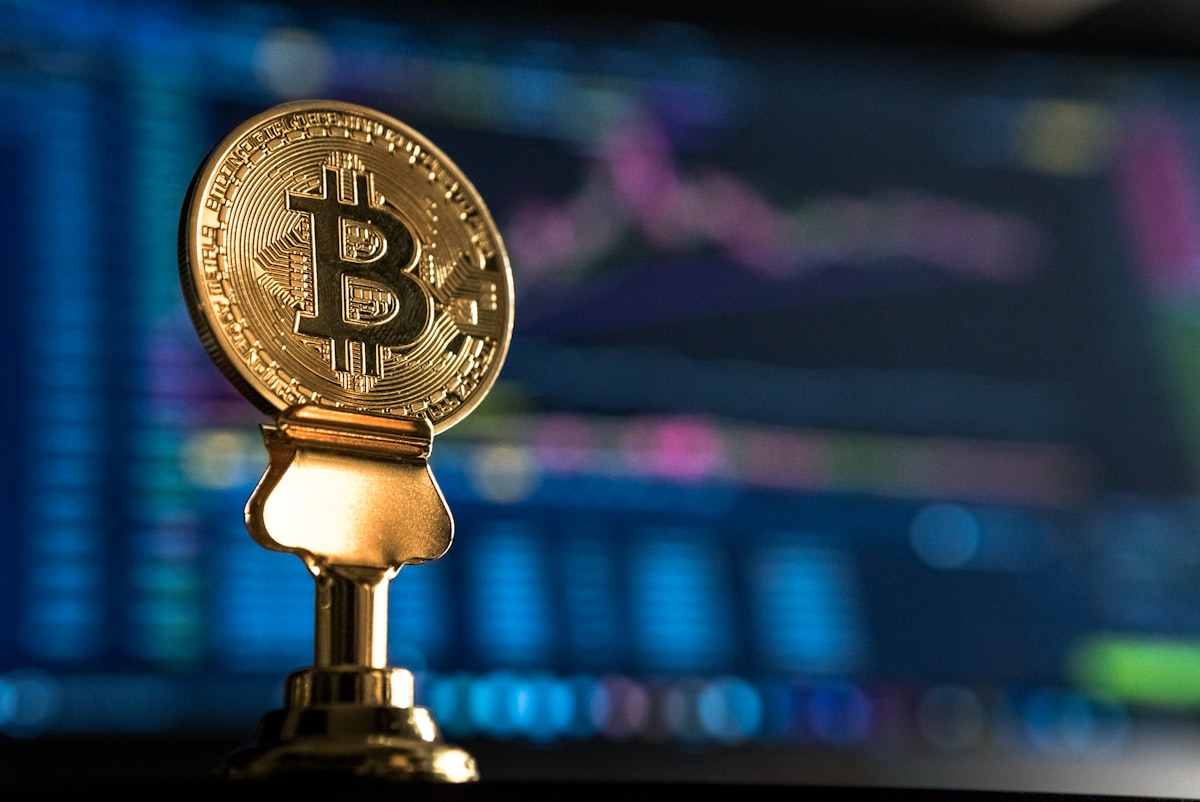Bitcoin for beginners: a dive into digital gold

In 2010, a programmer named Laszlo Hanyecz made what would become one of the most iconic transactions in cryptocurrency history: he paid 10,000 bitcoins for two pizzas. At that time, the value of those bitcoins was nominal, but fast forward to today, and those pizzas would be worth hundreds of millions of dollars! It's an anecdote that captures the wild journey of Bitcoin, from obscurity to a household name.
Fun fact: every 22nd May, Bitcoin affecionados celebrate the Bitcoin Pizza day, to mark the anniversary of the first Bitcoin transaction.
Bitcoin, often referred to as digital gold, is the first and most well-known cryptocurrency. But what exactly is it? How did it come about? And why are so many people talking about it? Let's dive in and find out.
Where it all started
Before we jump into what Bitcoin is, I think it’s important to understand what triggered the creation of it: the 2008 financial crisis.
In the early 2000s, there was a housing boom in the United States. Banks, flush with cash, eagerly handed out loans to almost anyone, sometimes without proper checks. The infamous "subprime mortgages" were born, targeting borrowers with poor credit histories. The idea was simple yet dangerously flawed: lend money to people to buy houses, assuming housing prices would always go up.
But in 2007, the housing bubble burst. Home prices plummeted, leaving homeowners with properties worth less than their loans. Foreclosures skyrocketed, and banks found themselves holding assets worth far less than expected. Big financial institutions had bundled these risky mortgages into complex financial products called mortgage-backed securities (MBS) and collateralized debt obligations (CDOs). These were sold globally, spreading the risk far and wide. When the mortgage defaults began, it wasn't just a few banks in the US that felt the heat. The contagion spread through the global financial system.
Lehman Brothers, a titan in the banking sector, declared bankruptcy in September 2008. This event sent shockwaves through the global markets. The stock market crashed, and major financial institutions teetered on the brink of collapse. The crisis had officially spiraled into a global phenomenon.

Governments and central banks around the world scrambled to contain the fallout. In the US, the government rolled out massive bailout packages for banks and other financial institutions. The Federal Reserve slashed interest rates to near zero, hoping to stimulate the economy.
The impact was not just limited to the financial sector. The crisis triggered a global recession. Unemployment soared, businesses folded, and economies around the world contracted. The ripple effects were felt in every corner of the globe, from Europe to Asia.
If you want to read more about the 2008 financial crisis and other crisis, read my other article.
The birth of Bitcoin
In the wake of the 2008 financial crisis, an anonymous figure or group, known by the pseudonym Satoshi Nakamoto, published a whitepaper titled "Bitcoin: A Peer-to-Peer Electronic Cash System." The 2008 financial crisis caused a lot of people to lose faith in banks as trusted third parties. Many questioned whether banks were the best guardians of the global financial system. Bad investment decisions by major banks had proved catastrophic, with rippling consequences. Bitcoin was aiming at solving that issue, allowing for online payments to be sent directly from one party to another, without going through a financial institution.

By January 2009, Nakamoto had released the first Bitcoin software, and soon after, the inaugural Bitcoin transaction was processed (2 pizze for 10,000 BTC) - and yes, the correct plural of "pizza" in Italian is "pizze". Over a decade has passed, but the true identity of Nakamoto remains one of the digital age's most captivating enigmas. As the years progressed, Bitcoin's trajectory saw highs and lows, with its value, adoption, and public perception constantly in flux. It moved from being an obscure project among crypto enthusiasts to a globally recognized phenomenon, capturing the imagination of millions.
Fun fact: as November 2023, the market cap of Bitcoin was close to $700B, or 50% of the total cryptocurrencies combined.
Understanding the technology: Blockchain
Although it is not my intention to do a deep dive into the nitty gritty of the tech behind Bitcoin, I do believe it's important to get a grasp around a few concepts, as it will help understanding why Bitcoin doesn't need a central authority (like a bank).
Blockchain, the underlying technology of Bitcoin, can be envisioned as a continuously growing digital ledger distributed across a vast network of computers. This decentralization is key to its functionality. Each 'block' in the blockchain contains a batch of transactions, and every time a new transaction occurs, it's recorded in everyone's ledger. Once a block of transactions is complete, it's added to the chain in a linear, chronological order, creating a historical record that's transparent and tamper-resistant. This is because once a block is added to the chain, altering it retroactively would require not just altering that block but all previous blocks, which becomes computationally impractical (a.k.a. very difficult) on large networks.

This technology gained fame through cryptocurrencies like Bitcoin, but its potential extends far beyond. From supply chain management to voting systems, its ability to provide secure, transparent, and decentralized record-keeping is proving revolutionary in various sectors.
The business side of things: Bitcoin mining
One important thing is that in principle anyone could start validating the blocks. In practice though, that's rarely the case. This is because transactions get added to the blockchain through a process called Bitcoin mining.
Bitcoin mining is a process that combines elements of cryptography, network theory, and economics. Here's how it works: miners use powerful computers to solve complex mathematical puzzles, which are essential for verifying and adding transactions to the blockchain. This process is called "proof of work," and it's designed to be resource-intensive and challenging to ensure network security and integrity. This means that the average Joe with his PC/server would basically waste electricity to try and solve the puzzle with having almost zero chance of mining, compared to people that spent thousands of dollars in IT equipment and leverage green energy to save on electricity.
Fun fact: even the most efficient Bitcoin mining operation takes roughly 155,000 kWh to mine one Bitcoin. By way of comparison, the average US household consumes about 900 kWh per month.
When a miner successfully solves a puzzle, they have the right to add a new block of transactions to the blockchain. This achievement is rewarded with newly minted bitcoins (known as the "block reward") and transaction fees paid by users. This dual incentive is crucial: it motivates miners to keep the network secure and efficient.

The block reward, which halves approximately every four years in an event known as the "halving," is a critical aspect of Bitcoin's economic model. It not only incentivizes mining but also controls the rate of new bitcoin creation, mimicking the scarcity and gradual discovery of precious metals like gold. This scarcity is part of what gives Bitcoin its value.
Fun fact: due to its design, the maximum amount of bitcoins is set at 21 million. This means that the last available bitcoin will be mined in year 2140, after which no new bitcoins can be mined.
For miners, the allure is twofold: there's the potential profit from the block reward and transaction fees, and the satisfaction of playing a pivotal role in securing the world's largest decentralized digital currency.
Bitcoin's significance in today's economy
Bitcoin, especially in the past years has captivated investors, rattled central banks, and stirred up quite the controversy in financial circles. Bitcoin's emergence as a prominent player in today's economy marks a paradigm shift in how we perceive and utilize money. As the first decentralized digital currency, Bitcoin challenges traditional financial systems by offering a peer-to-peer network, free from central authority control. This aspect resonates strongly in an era where people are increasingly conscious of privacy and autonomy over their financial transactions.
There's evidence that Bitcoin has been used for various illegal transactions, such as on dark web marketplaces. Websites like Silk Road, which was shut down by the FBI, famously used Bitcoin as a means of conducting untraceable transactions for illegal drugs and other illicit goods and services. At the same time, several well-known companies and stores have started accepting Bitcoin as a form of payment, reflecting the growing mainstream acceptance of cryptocurrencies. Companies like Microsoft, Tesla, Starbucks and PayPal (just to name a few), do accept Bitcoins as a payment method, proving the importance in today's economy.
Many Central banks have started studies and pilots on National Digital Currencies (CBDC), that although are not really the same things as Bitcoin, they are attempts at embedding some of the aspects into the existing financial system.
Is Bitcoin the new digital gold?
Bitcoin is often dubbed "digital gold," and it's easy to see why some people make the comparison. Just like gold, there's only so much Bitcoin to go around — its supply is capped at 21 million. This scarcity is a big deal for those who worry about inflation devaluing their cash. Plus, Bitcoin isn't controlled by any government or central bank, which for many, adds to its allure as a modern-day refuge in shaky economic times, much like gold has been historically.
But not everyone's buying this comparison. Sure, Bitcoin's got its perks, but it's also got a wild side — its price can zoom up and crash down at the drop of a hat, which isn't exactly what you'd call a stable store of value like gold. And let's talk about Bitcoin's track record; it's a newbie compared to gold's centuries of being the go-to asset in troubled times. Then there's the whole environmental angle — Bitcoin mining uses a lot of energy, which isn't a great look.
So, while some folks are all in on Bitcoin being the new gold for the digital age, others are a bit more skeptical. It's a lively debate, with Bitcoin straddling the line between a potential safe haven and a high-stakes investment gamble.
Investment potential: pros and cons
Many people went broke. Others got rich. So what's the truth? What you see below is the price in USD of 1 Bitcoin (the ticker is BTC), over the past 5 years. Even without knowing advanced technical analysis, I'm sure you've noticed the big swings in price.

If you were to buy in 2020 and have the guts to hold until 2022, when the price went over 64 thousand dollars, the increase in value would have (potentially) made you rich. The truth is, timing the market is VERY hard, and doing it constantly is practically impossible. This is even harder for Bitcoin, where trades can be done 24/7 and the price tends to swing a lot (in both directions). These factors make predicting the Bitcoin price very hard, even harder than predicting stock prices. And that's why many investors (professionals or not), got burnt badly. Does this mean you should steer away from it? It depends on your risk appetite.
Investment banks were initially skeptical, but things have changed and many have warmed up to its potential. Firms like Goldman Sachs and JPMorgan Chase have started offering Bitcoin-related investments to their clients, acknowledging its growing mainstream appeal. Today many financial advisors recommend to hold a small percentage of cryptocurrencies like Bitcoin in the average portfolio, either as actual Bitcoin or through some ETF, the latter being definitely easier for non tech savvy people.

How to invest in Bitcoin
Let's assume that after reading this article so you want to go and grab some Bitcoins, how can you do that? There are at least 3 options at your disposal:
- Physical ATM/teller
- Exchange
- ETF
Let's take a look at each of them.
Physical ATM/teller
At the moment there are about 30 different types of bitcoin ATMs with about 20 manufacturers having their units actually installed somewhere. There are websites like Coinatmradar.com that track them, or just search online for "Bitcoin ATM near me".

Once you've found your ATM/teller, the steps are pretty standard:
- Verification step (optional and may vary substantially depending on machine’s type)
- Provide bitcoin address for deposit (optionally can be generated and printed/emailed at some ATMs on the fly, but better to have your own with you before using a machine) - This is the equivalent of your investment account BUT its not the same thing. You will need a specific account for cryptocurrencies.
- Insert cash into the ATM
- Confirm operation (bitcoins sent to your bitcoin address at this moment)
This option is good for people that are not very tech savvy.
Fun fact: Bitcoins (and cryotocurriencies) are stored on wallets, think of it as the crypto version of a bank account. There are Online wallets, also known as hot wallets (apps on computers, phones, or tablets) and Hardware, also known as cold wallets (they are not connected to the internet and is at less risk of being compromised).
(Crypto) Exchange
Another option is to get Bitcoins online, through a Cryptocurrency exchange. In this case you can either use your credit card (e.g. Coinbase.com) or exchange other cryptocurrencies such as Ethereum, Ripple, etc. for Bitcoin. There are many exchanges out there, but the biggest by traded volume is called Binance (you can also use Coinbase although the selection of cryptocurrencies is smaller).
The steps required might differ slightly but on high levels are:
- Visit a cryptocurrency exchange website.
- Create an account and verify your identity as required.
- Follow the website's instructions to buy your bitcoin (BTC) or other digital asset.
- Your bitcoin will appear in your exchange account.
Fun fact: the smallest unit of Bitcoin that can be bought is called a "Satoshi." Named after Satoshi Nakamoto, the pseudonymous creator of Bitcoin, a Satoshi is equivalent to one hundred millionth of a Bitcoin. In other words, 1 Bitcoin is equal to 100,000,000 Satoshis.
This option is good for people that like to get their hands dirty and are a bit tech savvy.
ETF
The last option at your disposal is to buy an ETF with exposure to Bitcoins. In this case investors can buy and sell the fund like they would any other stock trading on an exchange, making it simple to get started.
If you want to focus solely on Bitcoin, then you can invest in ETF Futures (plus one option in the near future):
- Futures: These ETFs are created by purchasing futures contracts and bundling them into a fund. The investor then buys a fraction of the bundle. As reminder, a Future is a legal agreement to buy or sell a particular commodity asset, or security at a predetermined price at a specified time in the future. You're basically betting that the price will go up or down in the future. When it comes to Bitcoin Futures ETF there is a selection available, populare alternatives include:
-
ProShares Bitcoin Strategy ETF (BITO): BITO was the first Bitcoin futures ETF to be launched in the United States, and it is the most popular one by assets under management (AUM). As of October 2023, BITO had AUM of over $6.5 billion.
-
VanEck Bitcoin Strategy ETF (XBTF): XBTF is another popular Bitcoin futures ETF, with AUM of over $5.5 billion as of October 2023. XBTF is similar to BITO, but it tracks a slightly different index of Bitcoin futures contracts.
-
Simplify Bitcoin Strategy PLUS Income ETF (MAXI): MAXI is a Bitcoin futures ETF that is designed to generate income. It does this by investing in Bitcoin futures contracts and then lending out the Bitcoin that is underlying those contracts. MAXI has AUM of over $1 billion as of October 2023.
-
- Spot ETFs: a Bitcoin ETF that directly tracks the price of the cryptocurrency by owning Bitcoins (and not derivatives). At the time of writing there is no such ETF available, however at least nine asset management firms are waiting for Securities and Exchange Commission approval to issue a spot bitcoin ETF. The first approval could come early in 2024.
Conclusions
Although there have been many highs and lows, Bitcoin has survived all of them and its adoption is increasing every day. It went from being the toy of some nerds to (almost) mainstream, with stores accepting it as payment method and investment banks buying Bitcoins for the chance of some upside in the portfolios. The scene is still evolving every day, but cryptocurrencies are most likely here to stay.





